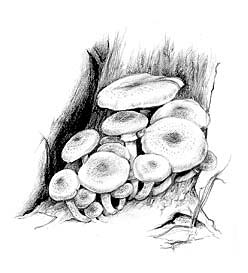Honey MushroomArmillaria melleaThe honeylike color of this white-spored gilled mushroom inspired its common name. This mushroom is very abundant. Variable in appearance, returning each year in many shapes and colors, what we call Armillaria mellea, (also known as the "oak mushroom"), may represent more than one species of mushroom. The caps can be red-brown to tan, smooth or scaled, with tan or pale brown fibrils. They may be small, rounded, and bell-like, or flat and fully expanded. They appear as individuals or in troops of hundreds. They are enjoyed worldwide. 
Their partial veils are frequently rudimentary or disappear early. The veil tissues are unique in this genus. The annular ring extends outward somewhat like the nodes on a bamboo stem. The honey mushroom grows both on dead wood and on living plants. It is capable of attacking and killing many kinds of trees, especially oaks. We have seen hundreds of caps erupting in clumps from the trunk and roots of a single tree. The mycelia of this organism may be compressed into a network of shiny black rootlike filaments called rhizomorphs, meaning "shaped like roots." These strands extend along tree trunks, under rocks, and follow roots underground searching for new food sources. For instance, they will consume all the plants of the cabbage family they can reach. Logs in moist forest environments may glow at night with a cool, blue-green emanation called "fox fire." This phenomenon is caused by a chemical produced by the mycelia of the honey mushroom. Certain orchids depend on A. mellea to wet-nurse their seeds until they erupt from the ground to begin photosynthesizing their own sugars. The orchid seedlings must grow underground for several years, during which time this fungus provides them with basic nutrients for survival. Those who collect the honey mushroom for food prefer solid, young, unopened buttons. When cooked, it is firm and granular. To some it is moderately sweet in flavor, but its edibility is marred for others by a mild bitter aftertaste and a somewhat gelatinous surface. Occasional incidents of gastric upsets have been reported with this mushroom so caution should be used when it is first eaten. CleaningBrush debris from the caps and gills under running water. Only the caps are used, for the stems are fibrous and inedible. CookingThis mushroom is admired in many countries of the world for its firm meaty texture. Most recipes call for combining it with other ingredients, rather than preparing it alone. It can be substituted in any basic recipe. Because of its dense consistency, it tolerates long cooking without losing its shape. For those people who experience a slightly bitter aftertaste, it is advised to parboil the caps for 5 minutes and to discard the water. PreservingWhen dried and reconstituted, the honey mushroom is quite agreeable in soups, stews, and mushroom loaves. Many people pickle the buttons in their favorite spices for immediate or later use. Spicy Honey Mushroom RelishMakes 1 pint
Honey Mushroom SaladServes 2 to 3 as a salad
ALTERNATE MUSHROOM: Shiitake Pork Stew with Honey MushroomsServes 4 as a main course
ALTERNATE MUSHROOMS: Black Saddle Mushroom, Hedgehog Mushroom |